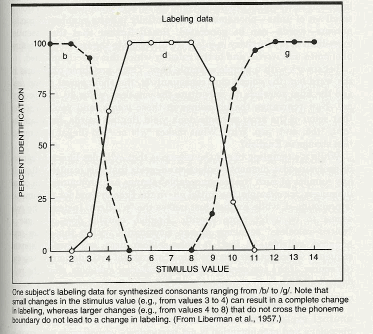 | ||||
| Oh cool - real data! Transitions from /ba/ to /da/ to /ga/ happen slowly, but we perceive that they happen suddenly. |
Researchers at Duke University found out that similar to humans, birds use categorical perception when they perceive bird song. In this case, the length of certain notes in swamp sparrow song were categorized. When a New York population of swamp sparrows heard the notes, they responded differently if the note lasted less than 13 milliseconds than if it lasted more than 13 milliseconds. Thirteen milliseconds was the perceptual boundary between one type of song note and another.
Armed with the knowledge that birds perceive song notes categorically, the researchers wanted to know where in the brain categorical perception is encoded. They measured electrical impulses in different neurons in a region of the brain, the Higher Vocal Center (HVC), that is important in bird song learning, production and perception.
| Bird brained - the HVC contains sensorimotor neurons that project to Area X and regulate song perception |
The sensorimotor HVC neurons were sensitive to the note duration in a categorical manner. Different neurons responded to different notes depending on whether the notes were above or below that boundary in note duration. However, the researchers noticed something funny about what that boundary actually was. While the birds they measured from New York behaved differently if the note was shorter or longer than 13 ms, when they measured the brain, the categorical boundary was 20 ms! Now how could this be? The birds whose brains they measured were from a population in Pennsylvania. The researchers then measured the behavior of birds in PA, and they found that those birds behaved as if their categorical boundary was at 20 ms - matching the measurements from the brain. So, not only did they detect the neurons that encode categorical perception in the brain, but they found out that different populations have different boundaries for categorical perception.
By this point you are probably wondering why different populations would have different boundaries for categorical perception of note duration. You may even be wondering if it matches up to different lengths of note types in the songs from NY vs. PA birds, and you would be correct. The duration of note types change around 13 ms for NY birds, but change around 20 ms for PA birds.
| Data from the study! Song note duration changes around 13 ms for NY birds (solid gray line) but changes areound 20 ms for PA birds (solid black line). These changes correspond pretty nicely to the behavioral and neural boundaries of categorical perception (dotted lines) |
Do you have categorical perception?
Prather, J. F., Nowicki,
S., Anderson, R. C., Peters, S., & Mooney, R. (2009). Neural
correlates of categorical perception in learned vocal communication. Nature neuroscience, 12(2), 221-228.